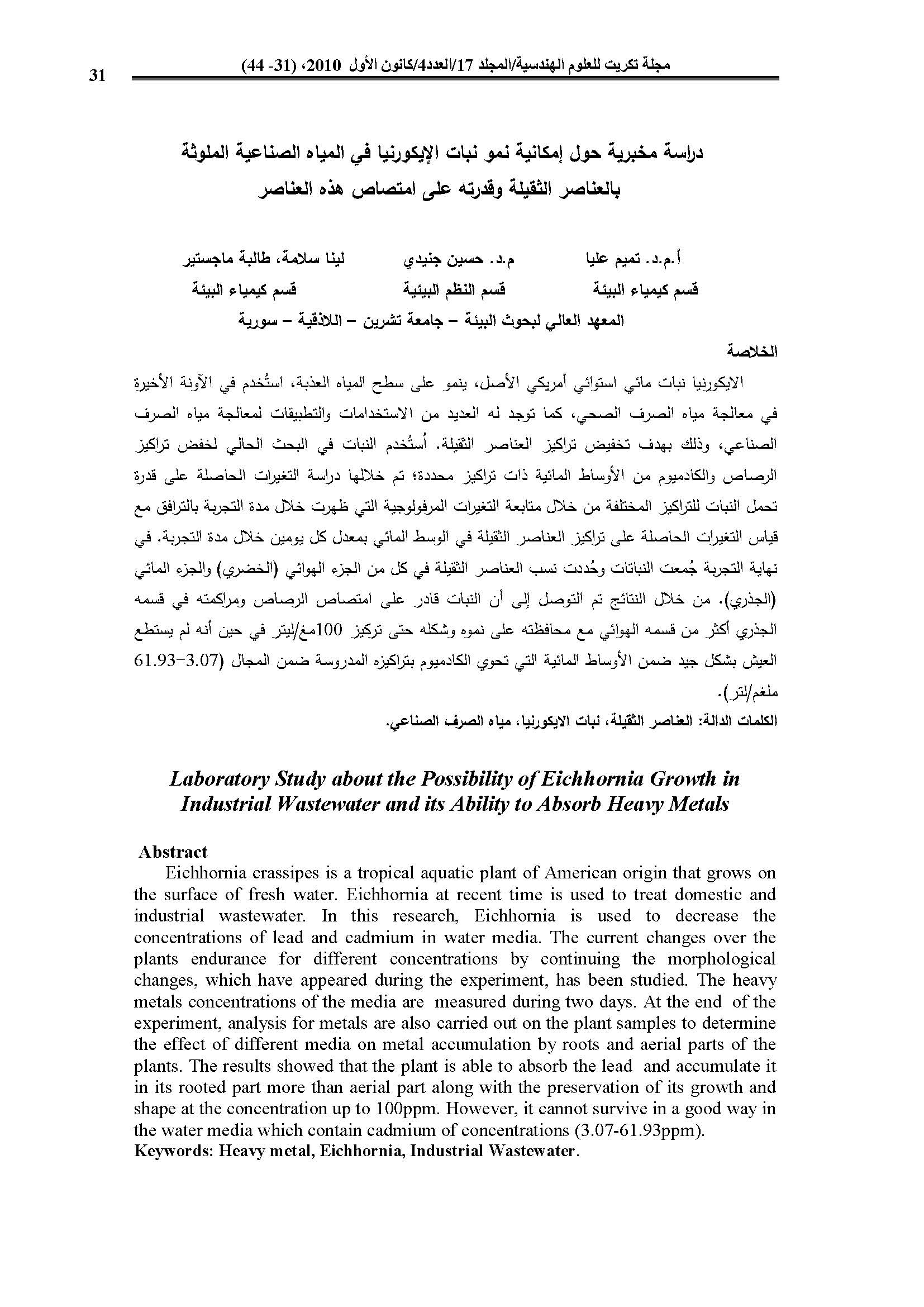Laboratory Study about the Possibility of Eichhornia Growth in Industrial Wastewater and its Ability to Absorb Heavy Metals
Main Article Content
Abstract
Eichhornia crassipes is a tropical aquatic plant of American origin that grows on the surface of fresh water. Eichhornia at recent time is used to treat domestic and industrial wastewater. In this research, Eichhornia is used to decrease the concentrations of lead and cadmium in water media. The current changes over the plants endurance for different concentrations by continuing the morphological changes, which have appeared during the experiment, has been studied. The heavy metals concentrations of the media are measured during two days. At the end of the experiment, analysis for metals are also carried out on the plant samples to determine the effect of different media on metal accumulation by roots and aerial parts of the plants. The results showed that the plant is able to absorb the lead and accumulate it in its rooted part more than aerial part along with the preservation of its growth and shape at the concentration up to 100ppm. However, it cannot survive in a good way in the water media which contain cadmium of concentrations (3.07-61.93ppm).
Metrics
Article Details

This work is licensed under a Creative Commons Attribution 4.0 International License.
THIS IS AN OPEN ACCESS ARTICLE UNDER THE CC BY LICENSE http://creativecommons.org/licenses/by/4.0/
Plaudit
References
Jayaweeraa, M. W.; Kasturiarachia, J. C.; Kularatea, R. K. A.; Wijeyekoon, S. L. J.”Contribution of water hyacinth (Eichhornia crassipes (Mart.) Solms) grown under different nutrient conditions to Fe-removal mechanisms in constructed wetlands”, Environmental Management 87, 450–460,2008. DOI: https://doi.org/10.1016/j.jenvman.2007.01.013
Nesic, N; Jovanovic, L. “Potential Use of Water Hyacinth (E. CRASSIPENS) for Wastewater Treatment in Serbia”, Center for multidisciplinary studies, University of Belgrade,2005.
Snyder, K. V. W.; Sjwp J. U.S .”Removal of Arsenic from Drinking Water by Water Hyacinths (Eichhornia crassipes)”, Portland, Oregon, October,41-58, 2006.
Win ,D.T.; Than, M. and Tun ,S. “Lead Removal from Industrial Waters by Water Hyacinth”. AU J.T. 6(4): apr,187-192,2003.
Sabet, M. D.; Nollet ,M .L. “Aquatic plants as indicators of heavy metal contamination”, Water Analysis. Peg 440,1997.
Mishra, V. K; Tripathi, B. D. “Concurrent removal and accumulation of heavy metalsby the three aquatic macrophytes”, BioresourceTechnology,no.99,7091–7097, 2008. DOI: https://doi.org/10.1016/j.biortech.2008.01.002
Mishra, V.K; Tripathi, B.D. “Accumulation of chromium and zinc from aqueous solutions using water hyacinth (Eichhornia crassipes)”, Hazardous Materials,) Article In Press (, 2008. DOI: https://doi.org/10.1016/j.jhazmat.2008.09.020
Lesage, E; Mundia, C; Rousseau, D.P.L; Van DE Moortel ,A.M.K; DU Laing, G; Meers. E; Tack, F.M.G; DE pauw, N; Verloo, M.G. ,”Sorption of Co, Cu, Ni and Zn from industrial effluents by the submerged aquatic macrophyte Myriophyllum spicatum L”. Ecological Engineering 3 0 ,320–325, 2007. DOI: https://doi.org/10.1016/j.ecoleng.2007.04.007
Gothberg, A; Greger, M; Bengtsson, B.E, “Accumulation of heavy metals in water spinach (Ipomoea aquatica) cultivated in the Bangkok region, Thailand”, Environmental –Toxicology- and- Chemistry21/9,pag 1934-1939, 2002. DOI: https://doi.org/10.1002/etc.5620210922
Ebel, M; Evangelou, M. W.H; Schaeffer, A. “Cyanide phytoremediation by water hyacinths (Eichhornia crassipes)”, Chemosphere 66/5,816–823, 2007. DOI: https://doi.org/10.1016/j.chemosphere.2006.06.041
Delgado, M; Bigeriego, M; Guaardiola, E. “Uptake of Zn, Cr and Cd by water hyacinths” ,Water Research [WATER RES]. Vol. 27, no. 2, 269-272,1993. DOI: https://doi.org/10.1016/0043-1354(93)90085-V
أ.د. أصفري, أحمد فيصل –معالجة مياه “الفضلات الصناعية”, مؤسسة الكويت للتقدم العلمي,321-3221996, .
Soltan, M.E; Rashed ,M.N. “Laboratory study on the survival of water hyacinth under several condition of heavy metal concentrations”, Environmental Research 7/2, 321–334,2003. DOI: https://doi.org/10.1016/S1093-0191(02)00002-3
Zaranyika , M. F; Mutoko, F; Murhawa, H. “Uptake of Zn, Co, Fe and Cr by water hycacinth (Eichhornia crassipes) in Lake Chivero, Zimbabwe”, Science of the total environment vol. 153, n.1-2, 117-121, 1994. DOI: https://doi.org/10.1016/0048-9697(94)90108-2
INGOLE, N. W; BHOLE, A. G. Removal of heavy metals from aqueous solution by water hyacinth (Eichhornia crassipes), Aqua – Journal of Water Supply: Research and Technology. Vol. 52, no. 2, 119-128, Mar 2003. DOI: https://doi.org/10.2166/aqua.2003.0012
S.H. Hasan, M. Talat, S. Rai, Sorption of cadmium and zinc from aqueous solutions by water hyacinth (Eichchornia crassipes), Bioresource Technology, Volume 98, Issue 4, Pages 918-928 ,March 2007. DOI: https://doi.org/10.1016/j.biortech.2006.02.042
Stratford H. Kay, William T. Haller, Leon A. Garrard, Effects of heavy metals on water hyacinths (Eichhornia crassipes (Mart.) Solms), Aquatic Toxicology, Volume 5, Issue 2, Pages 117-128, May 1984. DOI: https://doi.org/10.1016/0166-445X(84)90003-1





